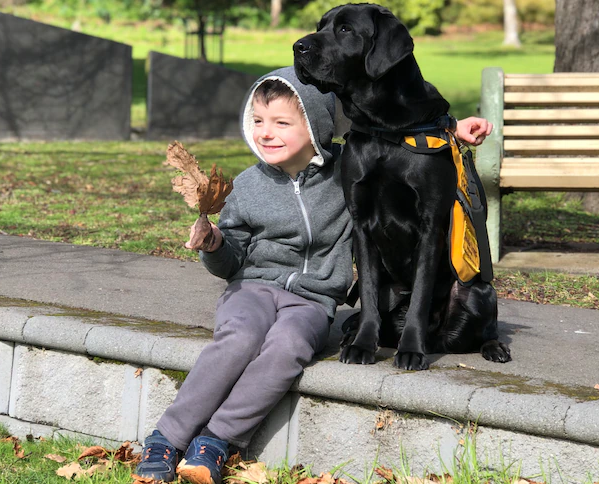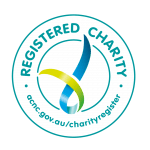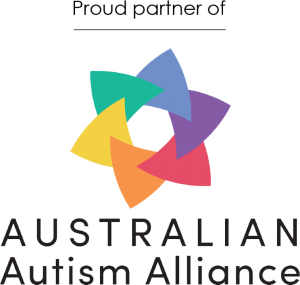After three years of battling with NDIS, the Bugg family have finally secured funding for an autism assistance dog (AAD) for their autistic son Lucas.
Relying on human touch to sleep at night, six-year-old Lucas found sleeping in his own bed impossible. However, just four weeks after getting his AAD his parents said “The benefits have been immeasurable. They’re just that massive.”
Lucas’ dog Vinnie is one of just a few assistance dogs funded through the NDIS. Funding is vital as it costs around $50,000 to train an AAD which is then provided to the family for free. Read the full story on ABC here.
Before funding an assistance animal, the NDIA will consider whether it’s a reasonable and necessary support that will meet your needs and help you to pursue your goals. To assess this the NDIS requires evidence in writing with input from all of the following:
- a registered assistance animal provider
- allied health professional(s)
- the participant.
For more information on assistance animals and the NDIS go to this page.
Lucas is a charming 6-year-old boy who loves trains, bubbles, blocks and water play. Lucas is autistic and has chronic sleep dysregulation as well as extreme difficulty with sensory regulation. Lucas has been accessing specialist support since he was a toddler and has had years working with a multidisciplinary team. It was from this team that the idea of an Autism Assistance Dog (AAD) emerged.
Natalie, Lucas’ dedicated mother, discussed the journey her family has been on in their 2-year quest for an AAD, funded by NDIS.
Natalie hopes that her story may help or inspire others to pursue funding through the ECEI or NDIS and while Lucas may be the first in Tasmania approved for an AAD, she hopes he will not be last.
What is an Autism Assistance Dog?
According to Guide Dogs Tas “An Autism Assistance Dog (AAD) improves the quality of life for both the child with autism, and their family, through safety, independence and inclusion.
An AAD assists with early intervention training for independence and to manage challenging situations while reducing levels of stress and distress. They help calm the child, distract or prevent meltdowns and interrupt repetitive behaviour patterns before sensory overload is experienced. An AAD will also help a child participate in social, leisure and educational activities, as well as reduce the stress associated with interaction with other people.
The dog’s presence can also encourage and increase social interaction of the child and their siblings and peers.”
Refer to the Guide Dogs Tas website for more information. https://guidedogstas.com.au/ourservices/aad/
Why is an Autism Assistance Dog (AAD) the best option for Lucas?
Lucas is easily overwhelmed and has extreme difficulty with sensory regulation, regular meltdowns, short attention span and struggles to comprehend the emotions of others. Despite the hard work and support of professionals, Lucas has always slept with others, mostly his parents. Lucas’ clinical psychologist first recommended this to Natalie, and this was quickly supported by his occupational therapist.
Natalie is hopeful this AAD will benefit the entire family, she explains
“I was pretty naive about autism assistance dogs at the start. I thought how could a dog do all of this? Lucas still sleeps in our bed, we have tried everything to change this, even participating in a sleep study. They found that even in REM (deep) sleep, Lucas still seeks out physical contact. If he doesn’t find it, he wakes up screaming and we have no hope of getting him back to sleep. We hope this will mean Lucas can finally sleep in his own bed with a trained dog by his side, rather than a human.”
What’s the process for applying for an Autism Assistance Dog (AAD)?
- Apply
There are steps the NDIS require you follow (see more on this here) but the main thing is to have all allied health professionals agree that this is the best option for the person, after first having tried a host of other more mainstream options. Once all treating health professionals agree, this is added to the client’s goal planning for their next meeting.
While Lucas was initially rejected a review then allowed for the “suitability for autism assistance dog assessment” to be completed in the 2019 plan review. The NDIS was very clear at this stage that this did not automatically mean the AAD would be approved.
NDIS then required behavioural assessment be completed prior to progressing the AAD application as Lucas exhibited “behaviours of concern”, funding for this was granted in November 2020.
The Behavioural Practitioner and Occupational Therapist both wrote letters in support of the dog and Lucas was assessed as suitable for an AAD by Guide Dogs Tasmania.
- Request a review of the decision (if needed)
With all this information provided to the NDIS, Lucas’ request for funding of the AAD was not approved. His family then requested a review of this decision and were again knocked back.
As this was the internal review of the decision their next step was the tribunal.
- Get support – Advocacy service if needed
This commenced December 2020 and they utilised advocacy services from Advocacy Tas. They assisted in completion of legal aid paperwork to assist in the review.
While they had all the reports needed and more, prior to the tribunal, the NDIS requested “fleshed out information” and requested the Occupational Therapist and Dog assisted Occupational Therapist sign off on Guide Dog’s Tasmania’s suitability assessment (this is a general Occupational Therapist to endorse the dog handler’s report and assessment).
As the dog trained for Lucas was ready, and could not be held for too long, the family were given a deadline by Guide Dogs Tasmania. Unfortunately, the NDIS did not meet the deadline and the family had effectively lost the dog. They requested their lawyer to add “failure to act as a model litigant” and two hours after they were made aware of this, the NDIS contacted the family and approved the dog for Lucas.
This confirmation was requested in writing so the family could secure the dog for Lucas.
What are your Top Tips for anyone in this process?
- Know your rights
- Use an advocate
- Speak up
- Copy your support coordinator/advocate in on everything
- Get verbal assurances in writing
- Keep all correspondence
- Get a great team around you who communicate with each other and are supporting each other’s recommendations to make one clear plan
- Don’t give up


 Autism Tasmania acknowledges the Australian Aboriginal people as the first inhabitants of the nation and the traditional custodians of the lands where we live, learn, and work.
Autism Tasmania acknowledges the Australian Aboriginal people as the first inhabitants of the nation and the traditional custodians of the lands where we live, learn, and work. 
